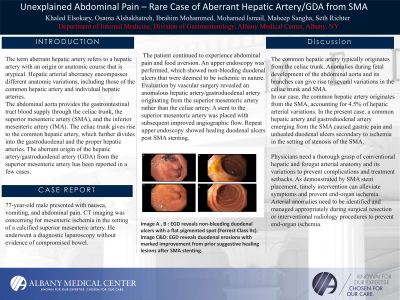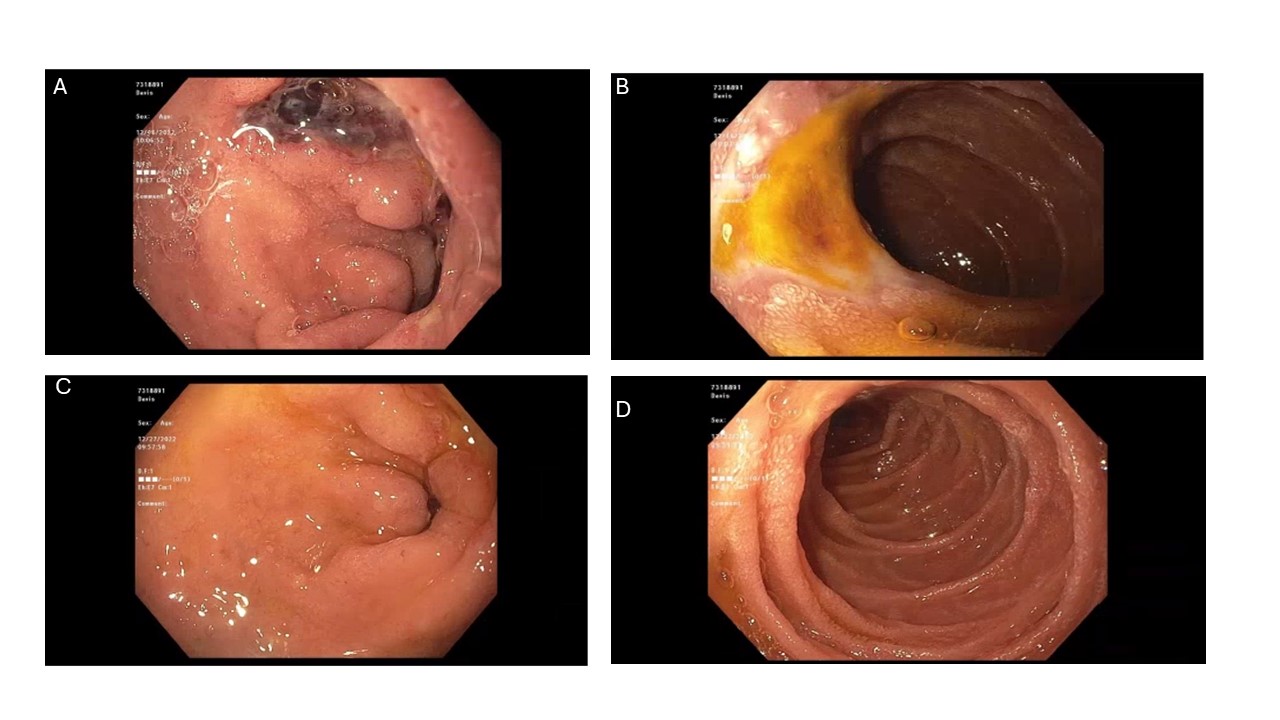Monday Poster Session
Category: Small Intestine
P3254 - Unexplained Abdominal Pain – Rare Case of Aberrant Hepatic Artery/GDA from SMA
Monday, October 28, 2024
10:30 AM - 4:00 PM ET
Location: Exhibit Hall E

Has Audio
- KE
Khaled Elsokary, DO
Albany Medical Center
Albany, NY
Presenting Author(s)
Khaled Elsokary, DO1, Osama Alshakhatreh, MD1, Ibrahim Mohammed, MD1, Mohamed Ismail, DO2, Maheep Sangha, MD1, Seth Richter, MD1
1Albany Medical Center, Albany, NY; 2Rutgers New Jersey Medical School, Newark, NJ
Introduction: The term aberrant hepatic artery refers to a hepatic artery with an origin or anatomic course that is atypical. Hepatic arterial aberrancy encompasses different anatomic variations, including those of the common hepatic artery and individual hepatic arteries.
The abdominal aorta provides the gastrointestinal tract blood supply through the celiac trunk, the superior mesenteric artery (SMA), and the inferior mesenteric artery (IMA). The celiac trunk gives rise to the common hepatic artery, which further divides into the gastroduodenal and the proper hepatic arteries. The aberrant origin of the hepatic artery/gastroduodenal artery (GDA) from the superior mesenteric artery has been reported in a few cases.
Case Description/Methods: A 77-year-old male presented with nausea, vomiting, and abdominal pain. CT imaging was concerning for mesenteric ischemia in the setting of a calcified superior mesenteric artery. He underwent a diagnostic laparoscopy without evidence of compromised bowel. The patient continued to experience abdominal pain and food aversion. An upper endoscopy was performed, which showed non-bleeding duodenal ulcers that were deemed to be ischemic in nature. Evaluation by vascular surgery revealed an anomalous hepatic artery/gastroduodenal artery originating from the superior mesenteric artery rather than the celiac artery. A stent to the superior mesenteric artery was placed with subsequent improved angiographic flow. Repeat upper endoscopy showed healing duodenal ulcers post SMA stenting.
Discussion: The common hepatic artery typically originates from the celiac trunk. Anomalies during fetal development of the abdominal aorta and its branches can give rise to several variations in the celiac trunk and SMA.
In our case, the common hepatic artery originates from the SMA, accounting for 4.5% of hepatic arterial variations. In the present case, a common hepatic artery and gastroduodenal artery emerging from the SMA caused gastric pain and unhealed duodenal ulcers secondary to ischemia in the setting of stenosis of the SMA.
Physicians need a thorough grasp of conventional hepatic and foregut arterial anatomy and its variations to prevent complications and treatment setbacks. As demonstrated by SMA stent placement, timely intervention can alleviate symptoms and prevent end-organ ischemia. Arterial anomalies need to be identified and managed appropriately during surgical resection or interventional radiology procedures to prevent end-organ ischemia.

Disclosures:
Khaled Elsokary, DO1, Osama Alshakhatreh, MD1, Ibrahim Mohammed, MD1, Mohamed Ismail, DO2, Maheep Sangha, MD1, Seth Richter, MD1. P3254 - Unexplained Abdominal Pain – Rare Case of Aberrant Hepatic Artery/GDA from SMA, ACG 2024 Annual Scientific Meeting Abstracts. Philadelphia, PA: American College of Gastroenterology.
1Albany Medical Center, Albany, NY; 2Rutgers New Jersey Medical School, Newark, NJ
Introduction: The term aberrant hepatic artery refers to a hepatic artery with an origin or anatomic course that is atypical. Hepatic arterial aberrancy encompasses different anatomic variations, including those of the common hepatic artery and individual hepatic arteries.
The abdominal aorta provides the gastrointestinal tract blood supply through the celiac trunk, the superior mesenteric artery (SMA), and the inferior mesenteric artery (IMA). The celiac trunk gives rise to the common hepatic artery, which further divides into the gastroduodenal and the proper hepatic arteries. The aberrant origin of the hepatic artery/gastroduodenal artery (GDA) from the superior mesenteric artery has been reported in a few cases.
Case Description/Methods: A 77-year-old male presented with nausea, vomiting, and abdominal pain. CT imaging was concerning for mesenteric ischemia in the setting of a calcified superior mesenteric artery. He underwent a diagnostic laparoscopy without evidence of compromised bowel. The patient continued to experience abdominal pain and food aversion. An upper endoscopy was performed, which showed non-bleeding duodenal ulcers that were deemed to be ischemic in nature. Evaluation by vascular surgery revealed an anomalous hepatic artery/gastroduodenal artery originating from the superior mesenteric artery rather than the celiac artery. A stent to the superior mesenteric artery was placed with subsequent improved angiographic flow. Repeat upper endoscopy showed healing duodenal ulcers post SMA stenting.
Discussion: The common hepatic artery typically originates from the celiac trunk. Anomalies during fetal development of the abdominal aorta and its branches can give rise to several variations in the celiac trunk and SMA.
In our case, the common hepatic artery originates from the SMA, accounting for 4.5% of hepatic arterial variations. In the present case, a common hepatic artery and gastroduodenal artery emerging from the SMA caused gastric pain and unhealed duodenal ulcers secondary to ischemia in the setting of stenosis of the SMA.
Physicians need a thorough grasp of conventional hepatic and foregut arterial anatomy and its variations to prevent complications and treatment setbacks. As demonstrated by SMA stent placement, timely intervention can alleviate symptoms and prevent end-organ ischemia. Arterial anomalies need to be identified and managed appropriately during surgical resection or interventional radiology procedures to prevent end-organ ischemia.

Figure: Image A , B : EGD reveals non-bleeding duodenal ulcers with a flat pigmented spot (Forrest Class IIc).
Image C&D: EGD reveals duodenal erosions with marked improvement from prior suggestive healing lesions after SMA stenting.
Image C&D: EGD reveals duodenal erosions with marked improvement from prior suggestive healing lesions after SMA stenting.
Disclosures:
Khaled Elsokary indicated no relevant financial relationships.
Osama Alshakhatreh indicated no relevant financial relationships.
Ibrahim Mohammed indicated no relevant financial relationships.
Mohamed Ismail indicated no relevant financial relationships.
Maheep Sangha indicated no relevant financial relationships.
Seth Richter indicated no relevant financial relationships.
Khaled Elsokary, DO1, Osama Alshakhatreh, MD1, Ibrahim Mohammed, MD1, Mohamed Ismail, DO2, Maheep Sangha, MD1, Seth Richter, MD1. P3254 - Unexplained Abdominal Pain – Rare Case of Aberrant Hepatic Artery/GDA from SMA, ACG 2024 Annual Scientific Meeting Abstracts. Philadelphia, PA: American College of Gastroenterology.
